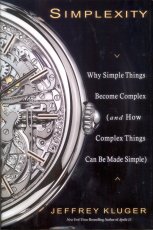 Excerpt
from Simplexity: Why Simple Things Become Complex (And How Complex Things Can Be Made Simple)
Excerpt
from Simplexity: Why Simple Things Become Complex (And How Complex Things Can Be Made Simple)
by Jeffrey Kluger
Confused by Fear
Confused by Fear
It would be a lot easier to enjoy your day if there weren't so many things trying to kill you before sundown. The problems start before you're even fully awake. There's the fall out of bed that kills six hundred Americans each year. There's the early morning coronary, which is 30 to 50 percent likelier than the kind that strikes later in the day. There's the fatal tumble down the stairs, the bite of sausage that gets lodged in your throat, the slip in the snow as you leave the house, the highspeed automotive pinball game that is your daily commute.
Other dangers stalk you all day long: Will a cabby's brakes fail when you're in the crosswalk? Will you have a violent reaction to spoiled food or the wrong medicine? And then there are the risks that are peculiar just to you: the family history of heart disease that claimed your father and grandfather in their fifties and could be shadowing you as well; the stubborn habit of taking chances on the highway that has twice landed you in traffic court and could just as easily land you in the morgue.
Trailed by danger the way we are, you'd think we'd get pretty good at distinguishing the risks that are likeliest to do us in from the ones that are statistical long shots. But you'd be wrong. We agonize over avian flu, which has killed only a small handful of people around the world so far, but have to be cajoled into getting vaccinated for common flu, which claims the lives of thirty-six thousand Americans each year. We wring our hands over the mad cow pathogen not likely to be in our hamburger and ignore the cholesterol that is-and that helps kill seven hundred thousand of us annually from heart disease. We avoid the water when we go to the beach for fear of a statistically unlikely shark attack, then fail to use the sunscreen that will protect us from a far likelier case of skin cancer.
Have we simply become overwhelmed by all the fear and uncertainty we face -- remaining understandably jumpy over the 3,000 who died on September 11, for example, but giving little thought to the 220,000 who have perished on the nation's highways since? Looking askance at so benign a thing as spinach for fear of E. coli infection but filling our shopping carts with fat-sodden doughnuts and salt-encrusted nachos?
We pride ourselves on being the only species that understands the concept of risk, yet we have a confounding habit of worrying about mere possibilities while ignoring probabilities, building barricades against perceived dangers while leaving ourselves exposed to real ones. We micromanage the contaminants we allow to touch us, putting filters on faucets, installing air ionizers in our homes, lathering ourselves with antibacterial soap. "We used to measure contaminants down to parts-per-million," says Dan McGuinn, a former Capitol Hill staffer and now a private risk consultant. "Now it's parts-per-billion or -trillion."
At the same time, 20 percent of all adults still smoke; nearly 20 percent of drivers and more than 30 percent of backseat passengers don't use seat belts; two-thirds of us are overweight or obese. We dash across streets against the light, build our homes in hurricane-prone areas, and when they're demolished by a storm, rebuild in the same spot. We allow ourselves to be talked out of sensible fears by manufacturers with products to sell -- unhealthy foods, unsafe cars, cigarettes -- and talked into irrational ones by politicians warning that electing their opponents will mean a nation debauched or endangered or worse. Rational calculation of real-world risks is a multidimensional math problem that sometimes seems entirely beyond us. And while it may be true that it's something we'll never do exceptionally well, it's almost certainly something we can learn to do better.
If risk is hard for human beings to parse, it's partly because we're moving through the modern world with what is, by many measures, a very primitive brain. We may think we've grown accustomed to living in a predator-free environment in which most of the dangers of the wild have been pushed away and sealed out, but as far as our slowly evolving central nervous system goes, this is a very recent development.
Joseph LeDoux, professor of neuroscience at New York University and author of the book The Emotional Brain, has studied fear pathways in laboratory animals and believes that much of what he's learned applies to human beings too. The jumpiest part of the brain -- in both lab mouse and human -- is the amygdala, a primitive, almondshaped clump of tissue situated not far above the brain stem. When you spot potential danger -- a stick in the grass that may be a snake, a shadow around a corner that could be a mugger -- it's the amygdala that gets the message first, triggering the fight-or-flight reaction that causes you jump. A fraction of a second later, higher regions of brain get the signal and sort out if the danger is real or not. That fraction of a second, however, gives the fear response greater emotional impact than the rational response, that advantage doesn't disappear. The brain is wired in such a way that nerve signals travel more easily from the amygdala to the upper structures than from the upper structures back down. Setting off your internal alarm thus quite easy; shutting it down takes some doing.
Copyright © 2008 Jeffrey Kluger
